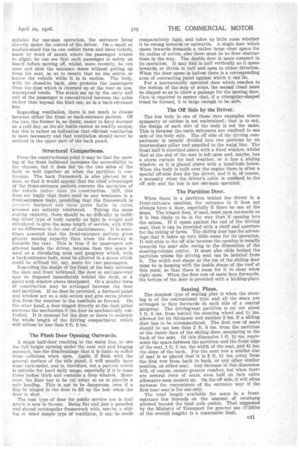The bus body is one of those rare examples where
Page 25

If you've noticed an error in this article please click here to report it so we can fix it.
symmetry of outline is not maintained ; that is to say, the design of each side of the body is not the same. This is because the main entrances are confined to one side of the body Only. The off side of the driving compartment is usually divided into two portions by an intermediate pillar and panelled to the waist line. The front half is provided above with a fixed window, whilst that at the end of the seat is left open and, maybe, has a storm curtain for bad weather, or it has a sliding window, or it is glazed above with a hand-hole below. When the body is built over the engine there is often a special off-side door for the driver, and it is, of course, a necessity when the driver's cabin is confined to the off side and the bus is not one-man operated.
The Partition Door.
When there is a partition behind the driver in a front-entrance omnibus, the entrance in it does not always have a door, especially if there be one at the steps. The hinged door, if used, must open outwards as it is less likely to be in the way than if opening into the saloon. If it opens against the eed of the driving seat, then it can be provided with a shelf and aperture for the taking of fares. The sliding door has the advantage that it takes up very little room for its operation. It will slide to the off side because the opening is usually towards the near side, owing to the disposition of the steering-column centre. It must also slide behind the partition unless the driving seat can be isolated from it. The width and shape at the top of the sliding door must be in keeping with the inside shape of the roof at this point, so that there is room for it to clear when right open. When the first row of seats face forwards, the bottom of the door is provided with a kicking-plate.
Seating Plans.
The simplest type of seating plan is when the steering is of the conventional type and all the seats are arranged to face forwards on each side of a central gangway. The driving-seat partition is set out about 1 ft. 6 ins, from behind the steering wheel and 1/ ins. allowed for its thickness and another 2 Ins, if a sliding door has to be accommodated. The first row of seats should be not less than 2 ft. 8 ins, from the partition or the inside face of the sliding door, measuring to the back of the seat. Of this dimension 1 ft. 1+ ins, represents the space between the partition and the front edge of the seat, 1 ft. 2 ins, the width of the seat, and 4/ ins. the slope of the back. For the next row a similar size of seat is so placed that it is 2 ft. 2/ ins, away from the first row from back to back, or any other similar position, on either seat. Any increase in this dimension will, of course, ensure greater' comfort, but when there are several rows of seats, even half an inch extra allowance soon mounts up. On the off side, it will often increase the convenience of the entrance way if the first near seat is for one only.
The total length available for seats in a frontentrance bus depends on the ameunt of overhang allowed beyond the hind axle centre. That suggested by the Ministry of Transport for general use (7-24ths of the overall length) is a reasonable limit.
































